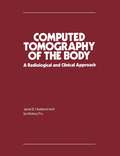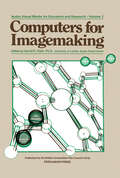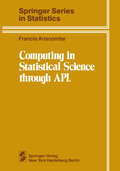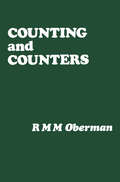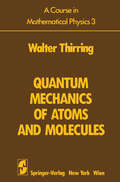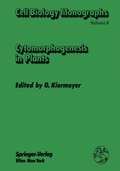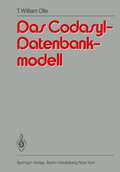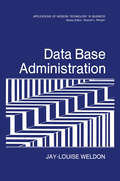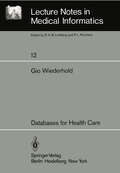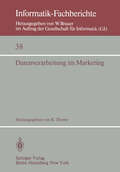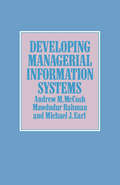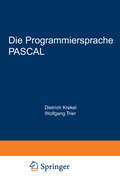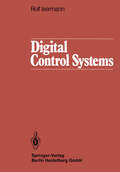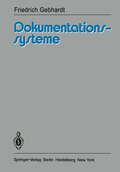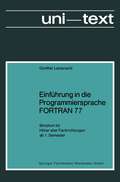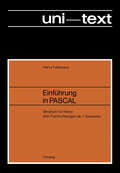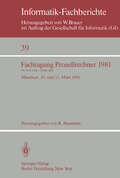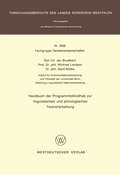- Table View
- List View
Computed Tomography of the Body: A Radiological and Clinical Approach (pdf)
by Janet E. Husband Ian Kelsey FryComputers for Imagemaking
by D. ClarkComputers for Image-Making tells the computer non-expert all he needs to know about Computer Animation. In the hands of expert computer engineers, computer picture-drawing systems have, since the earliest days of computing, produced interesting and useful images. As a result of major technological developments since then, it no longer requires the expert's skill to draw pictures; anyone can do it, provided they know how to use the appropriate machinery. This collection of specially commissioned articles reflects the diversity of user applications in this expanding field
Computing in Statistical Science through APL (Springer Series in Statistics)
by Francis John AnscombeA t the terminal seated, the answering tone: pond and temple bell. ODAY as in the past, statistical method is profoundly affected by T resources for numerical calculation and visual display. The main line of development of statistical methodology during the first half of this century was conditioned by, and attuned to, the mechanical desk calculator. Now statisticians may use electronic computers of various kinds in various modes, and the character of statistical science has changed accordingly. Some, but not all, modes of modern computation have a flexibility and immediacy reminiscent of the desk calculator. They preserve the virtues of the desk calculator, while immensely exceeding its scope. Prominent among these is the computer language and conversational computing system known by the initials APL. This book is addressed to statisticians. Its first aim is to interest them in using APL in their work-for statistical analysis of data, for numerical support of theoretical studies, for simulation of random processes. In Part A the language is described and illustrated with short examples of statistical calculations. Part B, presenting some more extended examples of statistical analysis of data, has also the further aim of suggesting the interplay of computing and theory that must surely henceforth be typical of the develop ment of statistical science.
A Course in Mathematical Physics 3: Quantum Mechanics of Atoms and Molecules
by Walter ThirringIn this third volume of A Course in Mathematical Physics I have attempted not simply to introduce axioms and derive quantum mechanics from them, but also to progress to relevant applications. Reading the axiomatic litera ture often gives one the impression that it largely consists of making refined axioms, thereby freeing physics from any trace of down-to-earth residue and cutting it off from simpler ways of thinking. The goal pursued here, however, is to come up with concrete results that can be compared with experimental facts. Everything else should be regarded only as a side issue, and has been chosen for pragmatic reasons. It is precisely with this in mind that I feel it appropriate to draw upon the most modern mathematical methods. Only by their means can the logical fabric of quantum theory be woven with a smooth structure; in their absence, rough spots would . inevitably appear, especially in the theory of unbounded operators, where the details are too intricate to be comprehended easily. Great care has been taken to build up this mathematical weaponry as completely as possible, as it is also the basic arsenal of the next volume. This means that many proofs have been tucked away in the exercises. My greatest concern was to replace the ordinary cal culations of uncertain accuracy with better ones having error bounds, in order to raise the crude manners of theoretical physics to the more cultivated level of experimental physics.
Cytomorphogenesis in Plants (Cell Biology Monographs #8)
by Oswald KiermayerIn 1958 E. BUNNING published a book in the former series "Proto plasmatologia" entitled "Polaritat und inaquale Teilung des pflanzlichen Protoplasten" (polarity and unequal division of the plant protoplast) in which for the first time results of experimental plant cytomorphogenesis were re viewed. This book was based completely on light microscopic observations and rather simple experimental techniques. Since then our knowledge of basic cytomorphogenetic mechanisms has greatly increased, especially with the introduction of modern ultrastructural, biochemical and sophisticated experi mental methods so that the field of cytomorphogenesis in our days should be considered a separate discipline within the general field of cell biology. This book, "Cytomorphogenesis in Plants", represents a necessary attempt to bring together current knowledge in this field of research on a comparable basis. Unfortunately enormous gaps in our understanding of the underlying principles of cytomorphogenetic events still exist. Therefore it seemed reason able to present a book composed of individual chapters, each written by experts for a defined experimental system. Each chapter represent a separate treatise with its own references, hence it was not possible to avoid some overlap both in the text and in the literature of the chapters without destroying the uni formity of the respective article.
Data Base Administration (Applications of Modern Technology in Business)
by Jay-Louise WeldonIn modem organizations, data has been added to the classical economic assets of land, labor, and capital. Data on company products, finances, and operations are gathered into data bases that are used to support management reporting and decision making. Effective use of these data bases requires control over their design and development and coordination among the various users. The exercise of these management functions is called data base administration (DBA). DBA is an evolutionary area. In many organizations, it was formed as a response to the problems created by the installation of sophisticated systems for data base management. As a result, the practice of DBA has been strongly influ enced by its technological and organizational environment. The size, organiza tional position, staffing, and defined role of DBA vary from firm to firm. How ever, certain fundamental tasks and responsibilities are, or should be, recognized as the province of DBA. To date, literature on the DBA function is sparse. Most texts on data base management systems (Date, 1975; Kroenke, 1977; Martin, 1978; Sprowls, 1976; Tsichritzis and Lochovsky, 1977)* discuss DBA as one aspect of that technology.
Datenverarbeitung im Marketing: Heidelberg, 9.–10. Oktober 1980 (Informatik-Fachberichte #38)
by R. ThomeDigital Control Systems
by R. IsermannThe great advances made in large-scale integration of semiconductors, the resulting cost-effective digital processors and data storage devi ces, and the development of suitable programming techniques are all having increasing influence on the techniques of measurement and con trol and on automation in general. The application of digital techni ques to process automation started in about 1960 when the first process computer was installed. From about 1970 computers have become standard equipment for the automation of industrial processes, connected on-line in open or closed loop. The annual increase of installed process compu ters in the last decade was about 20- 30 %. The cost of hardware has shown a tendency to decrease, whereas the relative cost of user soft ware has tended to increase. Because of the relatively high total cost, the first phase of digital computer application to process control is characterized by the centralization of many functions in a single (though sometimes in several) process computer. Such centralization does not permit full utilization of the many advantages of digital signal processing and rapid economic pay-off as analog back-up systems or parallel standby computers must often be provided to cover possible breakdowns in the central computer. In 1971 the first microprocessors were marketed which, together with large-scale integrated semiconductor memory units and input/output mo dules, can be assembled into more cost-effective process microcompu ters.
Einführung in die Programmiersprache FORTRAN 77: Skriptum für Hörer aller Fachrichtungen ab 1. Semester (uni-texte Programmiersprachen)
by Günther LamprechtFORTRAN IV ist die im wissenschaftlichen Bereich am weitesten verbreitete Programmiersprache. Für fast alle Rechenanlagen und in zunehmendem Maße auch in Tischrechnern ("intelligenten Terminals") stehen FORTRAN Compiler zur Verfügung. Bedingt durch das große Spektrum von Rechenanlagen mit den vielfältigen Bedürfnissen der verschiedensten Anwendungsgebiete wurden viele Sprach erweiterungen von FORTRAN IV vorgenommen, so daß heute eine fast unübersehbare Zahl von IISprachdialekten" vorliegt. Obwohl FORTRAN IV eine sogenannte höhere Programmiersprache ist und damit die Programme eigentlich unabhängig von der benutzten Rechenanlage sein sollten, haben die verschiedenen FORTRAN-Dialekte zu Umstellungsschwierigkeiten ge führt. Deshalb war es notwendig und konsequent, einen neuen FORTRAN Standard zu schaffen. Dies ist mit FORTRAN 77 geschehen, das im wesent lichen eine Erweiterung von FORTRAN IV darstellt und so die früheren Abweichungen soweit wie möglich in den Standard aufnimmt. Das vorliegende Buch führt in die Programmiersprache FORTRAN 77 an Hand von Beispielen ein, wobei gleichzeitig auf abweichende Sprachelemente von FORTRAN IV eingegangen wird. Die Beispiele und Aufgaben sind so gewählt, daß sie ohne allzu große Vorkenntnisse mit den dargestellten FORTRAN-Anweisungen gelöst werden können. Dabei lernt der Leser mit Ausnahme weniger Anweisungen den gesamten Sprachumfang von FORTRAN 77 kennen. Frau U. Kleinschmidt möchte ich an dieser Stelle für ihre Sorgfalt beim Schreiben der Druckvorlage danken.
Encyclopedia of Computer Science and Technology: Volume 16 - Index
by Jack Belzer""This comprehensive reference work provides immediate, fingertip access to state-of-the-art technology in nearly 700 self-contained articles written by over 900 international authorities. Each article in the Encyclopedia features current developments and trends in computers, software, vendors, and applications...extensive bibliographies of leading figures in the field, such as Samuel Alexander, John von Neumann, and Norbert Wiener...and in-depth analysis of future directions.
Encyclopedia of Computer Science and Technology: Volume 16 - Index
by Jack Belzer""This comprehensive reference work provides immediate, fingertip access to state-of-the-art technology in nearly 700 self-contained articles written by over 900 international authorities. Each article in the Encyclopedia features current developments and trends in computers, software, vendors, and applications...extensive bibliographies of leading figures in the field, such as Samuel Alexander, John von Neumann, and Norbert Wiener...and in-depth analysis of future directions.
Entwurf von Betriebssystemen: Eine Einführung
by A.N. Habermann1.1 Die Formulierung von Programmen 1.1.1 Ein Betriebssystem besteht aus zahlreichen Programmen sehr unterschied- 1 icher Größe. Nicht selten bewegt sich der Umfang eines Betriebssystems zwischen 100 Kund 500 K Bytes. Ein mittelgroßer Ubersetzer für eine Programmiersprache umfaßt dagegen nur 30 - 50 K Bytes. (K ist eine Abkürzung für "Kilo", d. h. "Tau 10 send". In der Informatik bedeutet K stets 1024=2 .) In diesem Buch studieren wir Betriebssysteme aus der Sicht des Systementwicklers. Das bedeutet, daß wir die verschiedenen Aufgaben eines Betriebssystems analysieren sowie Programme entwickeln, die diese Aufgaben erfüllen. Dabei wird aber weniger die Analyse als vielmehr die Synthese im Vordergrund stehen: wir erörtern, wie die Komponenten eines Betriebssystems unter vorgegebenen Bedingungen realisiert werden können. Dabei kann das vorl iegende Buch als Vorbereitung für andere Bücher dienen, welche sich mehr der Analyse von Betriebssystemen widmen. Wenn der Leser das ange botene Material durchgearbeitet hat, wird er für eine tiefergehende Analyse der Leistungsfähigkeit von Betriebssystemen und für eine Beschäftigung mit Warte schlangentheorie gut vorbereitet sein. Entwicklungsstudien bilden den angemessenen Hintergrund für die mathematische Analyse von Systemmodellen. Die Systemanalyse bleibt daher im vorl iegenden Buch auf den Vergleich einiger alternativer Entwürfe und Implementierungen beschränkt.
Erinnerungen an Robert Sauer: Beiträge zum Gedächtniskolloquium anläßlich seines 10. Todestages
by F. L. Bauer G. SchmidtError-Correction Coding for Digital Communications (Applications of Communications Theory)
by George C. Clark Jr. J. Bibb CainError-correction coding is being used on an almost routine basis in most new communication systems. Not only is coding equipment being used to increase the energy efficiency of communication links, but coding ideas are also providing innovative solutions to many related communication problems. Among these are the elimination of intersymbol interference caused by filtering and multipath and the improved demodulation of certain frequency modulated signals by taking advantage of the "natural" coding provided by a continuous phase. Although several books and nu merous articles have been written on coding theory, there are still noticeable deficiencies. First, the practical aspects of translating a specific decoding algorithm into actual hardware have been largely ignored. The information that is available is sketchy and is widely dispersed. Second, the information required to evaluate a particular technique under situations that are en countered in practice is available for the most part only in private company reports. This book is aimed at correcting both of these problems. It is written for the design engineer who must build the coding and decoding equipment and for the communication system engineer who must incorporate this equipment into a system. It is also suitable as a senior-level or first-year graduate text for an introductory one-semester course in coding theory. The book U"Ses a minimum of mathematics and entirely avoids the classical theorem/proof approach that is often seen in coding texts.
